Imagine, if you will, a mosaic.
Continue reading Mosaics, Metaphors, Monuments: Hochelaga Rock in Imaginary Perspective
Imagine, if you will, a mosaic.
Continue reading Mosaics, Metaphors, Monuments: Hochelaga Rock in Imaginary Perspective
The Illuminated Crowd is a sculpture located in downtown Montreal on rue McGill College created by Raymond Mason and erected in 1985. The statue is a bigoted piece that represents the ideology of western triumphalism and how those who don’t fall into that ideology are left behind and minimalized. The statue presents the literal light of the west as all powerful and that the farther away from the light you are the worse off you are, presenting those worse off as grotesque and the ones in the light as idealized westerners.

 The intervention’s aims are to express silenced voices and combat ethnocentricity, engage and criticize the concepts of western culture and superiority. Additionally the hope is to remove focus from unsightly art.
The intervention’s aims are to express silenced voices and combat ethnocentricity, engage and criticize the concepts of western culture and superiority. Additionally the hope is to remove focus from unsightly art.
The intervention consists of creating a series of photographs and written stories that represent people from all over Montreal, aiming to represent people all walks of life. These photographs are to be placed on columns along the perimeter of the area, facing the statue, with small plaques telling the photos’ stories. By gathering people and their stories, we hope to combat the ideology of the statue, additionally the placement would remove focus from the statue.
Disrupting the Visual Narrative of ‘Historical’ Indigenous Peoples: an Intervention on Le Collectif Au Pied Du Mur’s Mural in Pointe-Saint-Charles – Estelle Wathieu
The district of Pointe-Saint-Charles (South-West of Montreal) is located on unceded, Kanien’kehá:ka (Mohawk) traditional territory.

In September 2013, the Collectif au Pied du Mur inaugurated on Knox Street (Pointe-Saint-Charles) their first and only mural named La Pointe – All Dressed in the presence of 300 inhabitants of the district. [1] The project dated back from 2003 [2] when a development project (Action Populaire d’Aménagement) that aimed to improve the urban environment of the neighborhood was initiated by Action-Gardien, la Table de concertation communautaire de Pointe-Saint-Charles, an association gathering around twenty community organizations of Pointe-Saint-Charles. Inspired by this initiative, the anarchic group La Pointe Libertaire started their own mural in 2006, but they were instantly sued for vandalism, the wall on Knox Street being the propriety of the Canadian National Railway. After finding an agreement with the railway company, the collective partnered with the Carrefour d’éducation populaire of Pointe-Saint-Charles in 2012, received $20.000 from the artist organization ROUAGE / Engrenage Noir [3] in order to realize the mural painting, and the City of Montreal and the borough of the South-West funded the last $25.000. From November to May 2013, the collective prepared their intervention. Once they agreed on an outline, they presented the project to the inhabitants of the neighborhood during public presentations. The design of the mural being approved by the community, the mural was painted between May and September 2013. [4]
La Pointe – All Dressed: a positive evolution in the discourse around the origins of the neighborhood

Public consultation ≠ inclusive consultation
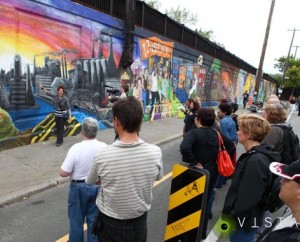
This public consultation process is in fact a laudable initiative, especially considering the short amount of time that the collective had to paint a mural of this scale. [5] From the beginning, the Collectif au Pied du Mur aimed to realize a mural in which the residents could recognize themselves and that would be anchored in the history of the neighborhood. Their desire to integrate and co-operate went so far as to invite the inhabitants of the neighborhood to paint with them on Fridays – within the few months of the project, two hundred children left their hand print on the mural and one hundred and fifty adults helped the team at least one time. [6] However, the fact that they visually represented Indigenous peoples on their mural without consulting beforehand any Indigenous community from Montreal [7] is questionable, firstly because Indigenous peoples are marginalized by the Canada settler state and that their depiction by descendants of settlers or immigrants that benefit from the current political system can be offensive and harmful for them. Secondly, because the mural was not meant to empower the Indigenous community, but the residents of Pointe-Saint-Charles. The valorisation of Pointe-Saint-Charles and its multiculturalism, as well as the celebration of its inhabitants and their commitment to the struggle for social justice were the stated goals of this mural.
The ‘historical’ and ‘assimilated’ Indigenous peoples: issues surrounding their visual representation in La Pointe – All Dressed
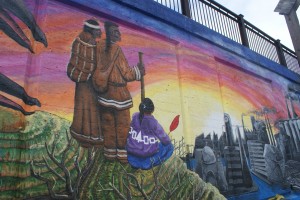
The absence of a dialogue between the artist collective and the local Indigenous communities of Montreal is not the only issue around the representation of Indigenous peoples in this mural. The way that the Indigenous peoples are depicted in the mural is also problematic. Represented on the left part of the mural, they are completely separated from the joyful crowd of the inhabitants of the neighborhood who are demonstrating for social justice. The Lachine Canal makes a clear distinction between the Indigenous past and the modernity symbolized by the industrialization. The risk with this representation is to participate in the discourse of ‘vanishing Indigenous peoples’ that does not correspond to the reality. Another issue lays in the attitude of the Indigenous figures that was chosen by the muralists. In fact, the muralists picture them with a ‘mean look’ that may diabolize the Indigenous peoples in general and convey the idea that they do not belong to the so-called ‘modernity’. But Indigenous peoples still live on this land, they are thus an integral part of the life of Montreal and Pointe-Saint-Charles. In 2006, 555 Indigenous peoples were living in the South-West of Montreal, one of the highest concentration of Indigenous peoples in Montreal [8]. Admittedly, the Collectif au Pied du Mur acknowledged their presence, incorporating Indigenous figures in the crowd, but they represented them as assimilated, advocating for social justice with the others, and not for their own rights. The whole mural gives the image of silent and passive Indigenous peoples: whether excluded from the ‘modernity’ or completely assimilated. Their voices were silenced in order to celebrate the multiculturalism of the neighborhood and the political engagement of its inhabitants.
Disrupting the visual narrative of La Pointe All-Dressed: an intervention
“It is useless for us to become involved in a struggle to improve our image, because native people did not create these images, and they should not be concerned with trying to improve them so that whites will respect them. The society would simply create new racist images for us to work at… ” —Howard Adams, Prison of Grass, 1975 [9]
Inspired by this idea, I chose not to imagine a new version of the mural painting that would that would not be problematic or offensive to Indigenous peoples, but to bring awareness to the issues related the representation of Indigenous peoples in La Pointe All-Dressed.
1- First, I initiated a discussion with two of the painters of the mural, Shaen Johnston and Marco Sivestro – who was also the coordinator of the project. They confirmed me that no consultation had been made with the Indigenous communities of Montreal, but that they would be open to have a conversation about the design of the mural.
2- Then, my physical intervention on the site of the mural meant to disrupt the visual narrative of the mural and to engage directly in a discussion with the inhabitants of the neighborhood. I put a poster on the mural saying in English and French: ”You are walking on unceded, Kanien’kehá:ka (Mohawk) traditional territory. Indigenous peoples are not only the past of this land, but its present and future.” (see below the video documentation of my intervention). I chose the form of a poster to keep with the activist spirit of the neighborhood where we can find many political posters in the public space. Moreover, in their book, the authors of the mural themselves encouraged the inhabitants to interact with the mural by adding posters to it.
3 – Finally, this textual intervention will document my critical approach of the mural, as well as my interventions. My hope here is to make my research available to a wider audience, leaving the door open to anyone who would like to engage in discussion with this site or the Collectif au Pied du Mur.
Notes:
[1] Chagnot, Johanne, in collaboration with various groups. Art communautaire militant. Projets 2012-2013. Montreal: Engrenage Noir / ROUAGE, 2013, 36.
[2] Or 2004, according to the website of the Community Clinic of Pointe-Saint-Charles <http://ccpsc.qc.ca/fr/node/251>.
[3] For more information on the organization, see their website. <http://engrenagenoir.ca/rouage/?lang=en>.
[4] For more information about the creation of the mural, see Le Collectif au Pied du Mur. The Pointe All Dressed. Montreal, 2013 (available at the public library of Pointe-Saint-Charles), and their website <http://lecollectifaupieddumur.tumblr.com>.
[5] This information comes from my inteview of Marco Silvestro, the coordinator of the projet and painter of the three Indigenous peoples on the left part on the mural painting.
[5] Measuring 80 metres by 5, the mural La Pointe All Dress is the longest permanent mural of Montreal. <http://lecollectifaupieddumur.tumblr.com/post/61412041445/inauguration-of-the-longest-permanent-mural>.
[6] Le Collectif au Pied du Mur, Ibid.
[7] This information comes from my inteview of Marco Silvestro, the coordinator of the projet.
[8] Indigenous peoples represent 0,8% of the total population in the South-West of Montreal, when the average is 0,5% and the maximum is 1% for the city of Dorval. Division des affaires économiques et institutionnelles de la ville de Montréal. Portrait de la Population autochtone à Montréal, 2010. Web. 16 Feb. 2016.
[9] Cited in Francis, Daniel. The Imaginary Indian: The Image of the Indian in Canadian Culture, Second Edition. Vancouver, BC, CAN: Arsenal Pulp Press, 2011. ProQuest ebrary. Web. 18 April 2016.
Estelle Wathieu
We decided to stage our intervention on the statue of Queen Isabella 1 of Castille located in Laurier Park. The Statue was gifted to the city in 1959 by the Consulate General of Spain in Montreal on behalf of the Institute of Hispanic Culture in Madrid.
Queen Isabella led the Spanish inquisition, which expelled the Jewish and Muslim populations from Spain. She was also the patron of Christopher Columbus who ‘discovered’ the Americas. Given the Queens violent history this memorial has not been without controversy.
Shloime Perel, an organizer for the Refugee Research Project in Montreal, wrote an opinion piece in the Montreal Gazette which cited the UN Convention for the Prevention and Punishment of Genocide, arguing that Isabella was guilty. He also contacted several local community members and politicians calling for the removal of the statue.
In December 2015 somebody doused the statue with red paint and attaching a sign saying “I AM GUILTY OF CRIMES AGAINST HUMANITY”.
However, neither of these actions subverted the western style of memorials; it was still Isabella who had to own the past.
By placing mirrors around the bust of the statue, we are countering the past intervention by confronting the public rather than the memorial. The mirrors simultaneously hide Isabella, and force the public to see their reflection, facilitating the opportunity to reflect. The inclusion of the Edict of the Expulsion of the Jews and the letter addressing Columbus’s voyages will be attached to the statue as proof of Isabella’s crimes, and as a way to cement our project give context to the viewer.
How has Isabella’s crimes permeated throughout our world today?
Is there a moral imperative to intervene at such contested sites?
State of Emergency in Attawapiskat
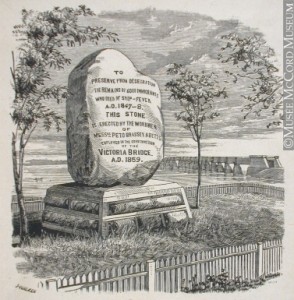
While the Victoria Bridge was being constructed around 1859, workmen discovered a mass grave that contained human remains. The remains were of the Irish immigrants who fled the famine in Ireland only to be affected by typhus or ship fever between 1847-1848. Those who were affected by typhus on their journey to Montreal were dropped off on an Island called Grosse- Ile in Quebec. For those who arrived in Montreal, they were quarantined in fever sheds and those who perished were hastily buried in mass graves. Many religious figures, the grey nuns for example, had helped those who were affected by the disease only to die by it as well. It is estimated that 6000 immigrants, who were mostly of Irish decent, died of typhus in fever sheds situated in Windmill Point, commonly known as Goose Village, not too far from the Victoria Bridge. In order to commemorate the thousands Irish immigrants who died of typhus, the workmen took a boulder from the Saint-Lawrence River, which became the “Irish Commemorative stone of Montreal” situated on Bridge Street on route 112 .
Today, the only living memory that connects to the Irish who died of typhus is the Black Rock that is situated in between two busy roads. The problem is mainly the location of the rock. Since it is situated on a small island on route 112, those who drive past don’t know what the significance of the big boulder in between the road is and the only description of the rock is on a small plaque across the road from the monument. Though the Irish community in Pointe Saint Charles organizes annual walks to the Commemorative Stone, the hope is to expand the awareness of the monument and why it is important to the larger Montreal community. The dream is to create a green space across from the monument, replacing the parking lot into a commemorative park. This green space will not only commemorate the Irish who died of typhus, but will also commemorate important Irish figures as well as remembering the Natives who occupied the land before Colonial occupancy. The goal of commemorating Irish figures and the natives is to show the importance and influence of the Irish in Montreal’s history as well as not forgetting the Indigenous people who occupied the land beforehand.
In the end, the Irish Commemorative Stone, though a symbol for the Irish who escaped the Famine in Ireland only to die of typhus on their arrival to Montreal, can be a symbol for the present day immigrants who sacrificed their lives in order to find a better one and the unknown risks they are willing to take to find a better life.
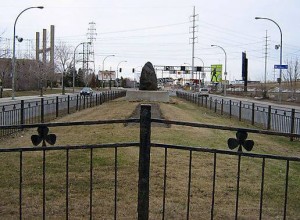

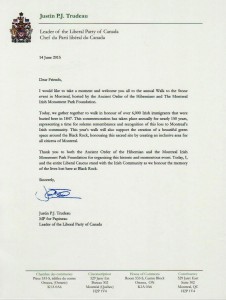
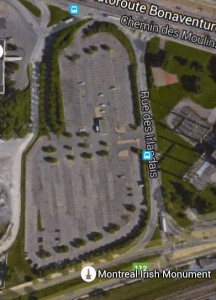
http://www.montrealirishmonument.com
Interview from Breakfast Television Montreal about the walk to the Irish Commemorative Stone
Long before Europeans sailed to Canada and began to settle themselves in the new territory, First Nations tribes had already existed there. When Jacques Cartier sailed over to the New World and planted his famous cross on Mount Royal to mark French territory in Canada, Native villages were already in place and had been for a while.
If one would go walking around Old Montreal today, they’d see very little reminders that First Nations peoples had lived on this land before the arrival of the European powers. Not much remains of the memory that indigenous peoples were once settled here a long time ago and laid part of the foundation of the Montreal we live in today.
OUR METHOD:
Our intervention consists of two main components: an augmented reality experience that can be accessed through a smartphone application combined with a walking tour. This augmented reality will fill in the blanks of Montreal’s creation story that have been overlooked: namely, the contribution of First Nations peoples. The sites we have chosen are the Pointe-A-Calliere Museum, Chateau Ramezay and the Lachine Canal. Upon arrival at these sites, members of the walking tour can hold up their phones and will be able to see the missing parts of the narrative.
OUR GOALS:
We seek to challenge the current narrative in place with our intervention. With the combined walking tour and augmented reality, we hope to raise questions concerning why the contributions of First Nations peoples are diminished compared to those of European settlers.